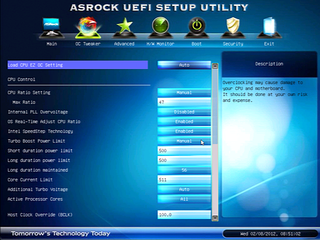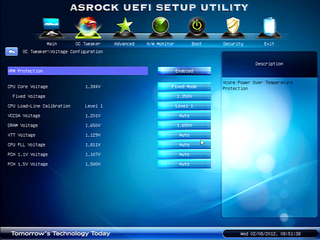Six $200-$260 LGA 2011 Motherboards, Reviewed
We know that Intel's X79 Express platform hosts the fastest desktop processors in the company's portfolio. But can it be made more affordable? We round up the least-expensive $200-$260 motherboards to determine how much you have to give up for cheap X79.
X79 Extreme4 Firmware
ASRock attacks the overclocking market on two fronts, with “CPU EZ OC” profiles up to 5.0 GHz, plus full manual controls. We recommend keeping any of Intel’s 32 nm CPUs below 1.40 V for increased longevity, and we perform our own comparative analysis at 1.35 V.

After suffering through two motherboard round-ups with a CPU bug for which only one of ASRock’s competitors had a workaround, we finally moved on to a new bug-free processor based on Intel's newer C2 stepping. Choosing 47 x 100 MHz gets us to a respectable 4.7 GHz, though the board’s 1 MHz BCLK increments prevented us from seeking a few MHz more (we would have liked to see more granularity there).

Memory data rates up to DDR3-2400 are available at stock base clock, though most Sandy Bridge-E processors require advanced tweaking to reach this data rate.

Voltage controls include CPU core and CSA, the latter assisting primarily in memory controller overclocking. Benchmarked at default settings, our memory gets bumped up to its recommended 1.65 V when overclocked.



Unlike most entry-level boards, the X79 Extreme4 adds secondary and tertiary timings to its manual memory configuration.
Stay On the Cutting Edge: Get the Tom's Hardware Newsletter
Join the experts who read Tom's Hardware for the inside track on enthusiast PC tech news — and have for over 25 years. We'll send breaking news and in-depth reviews of CPUs, GPUs, AI, maker hardware and more straight to your inbox.
-
I like Asrock boards. I have an 880GM-LE mATX and a Z68 Pro3 Gen3 ATX and both are good performance and price-performance wise.Reply
-
hellfire24 Asrock is dominating both high end and mid range market.extreme3/gen3 1155 is awesome and cheapest pci-e 3.0 sli capable mobo.Asrock FTW!!!Reply -
Achoo22 ReplyQuite simply, the costs associated with Sandy Bridge-E are higher, in part because of Intel's prices and also because the boards are more difficult to design.
Since the boards all have vastly superior profit margins, your statement is misleading. Why is everyone too afraid to reveal the truth about motherboard pricing? -
AlexIsAlex Would it be possible, in future motherboard reviews, to include a measure of the cold boot (POST) time? This is something that different bioses can be differentiated on, and UFEI offers the potential for very fast boots if manufacturers take advantage of it properly.Reply
A comparison of the time between the power button being pressed and the installed bootloader starting would be very interesting to me. I was thinking it might be easiest to measure this by having no OS on the boot media and measuring the time to the "please insert boot media" message, but I'm sure you can think of other ways of doing it.
I'm also informed that on some boards the boot time varies dramatically dependent on whether any Overclocking is enabled, as compared to the stock settings - that would also be worth knowing. -
americanbrian your feature table says the asrock extreme 4 comes with an 8 phase voltage regulator, but the text of article says 10 phase...which is it ?Reply -
KT_WASP crisan_tiberiuASRock = ASUSReply
not anymore, asrock is no longer affiliated with Asus and is owned by Pegatron Corp. -
memadmax I wish tom's would do a "best motherboards for the money" or something close to that.Reply
Most Popular




